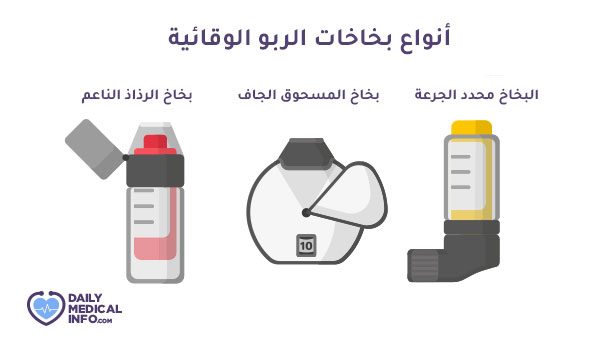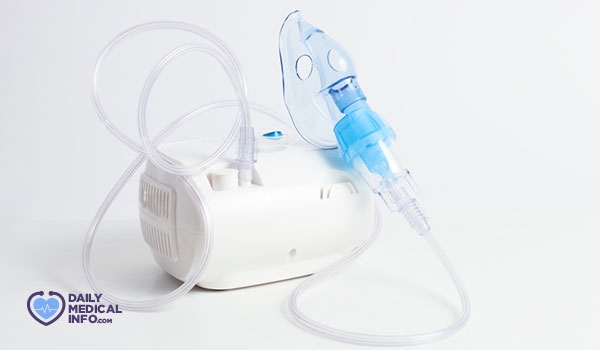Types of asthma inhalers and how to use them correctly
Asthma is one of the most common chronic respiratory diseases, which results in breathing difficulties. Although there is no cure for this disease, fortunately there are treatments to relieve symptoms and reduce seizures. Common treatments include asthma sprays and the nebulizer device. In this article, we will know more details about asthma sprays, so read the following lines.
Types of asthma inhalers
In terms of indications for use, there are two basic types of asthma inhalers, namely, emergency (treatment) inhalers, and preventive inhalers.
1. Reliever Inhaler
It is the type of inhaler that is used in emergency cases (blue asthma spray) to quickly relieve the current attack and calm the symptoms, as it works to relax the muscles in the airway, and thus breathing easier.
If you are suffering from an asthma attack, this type may be considered the “lifesaver” type, and it is advised to keep this inhaler with you at all times for emergency use when you notice any symptoms.
2. Preventive inhalers

Preventive nebulizers are the main treatment method for asthma. They are small doses of cortisone medication to reduce inflammation in the airway, thus improving breathing. In addition, they help make you less sensitive to asthma triggers. There are many types of preventive asthma nebulizers, as follows:
Metered dose inhalers
It is a nebulizer that is used in the form of a spray. It is a cylindrical tube inside a mouthpiece made of plastic. Its shape resembles the shape of a shoe. The mouthpiece is placed on the mouth, and then the rice is pressed to release the required dose.
Some types of preventive nebulizers contain a counter that shows you the remaining doses. They can be used with a spacer tube or a face mask, especially in children, or some adults, in order to obtain the largest percentage of the inhaled dose.
Dry powder inhaler
It is a spray for inhalation through the mouth, instead of releasing the dose directly like the previous type, the patient places his mouth on the designated place, then inhales the dose by breathing deeply and quickly, and there are types that contain a number of doses that may reach 200 doses And other types use a single dose that is filled from the capsule before it is taken.
Soft mist inhalers
This inhaler is slightly larger than a single dose inhaler, and releases the dose at a slower rate so that it can be inhaled slowly over longer periods of time than the previous two types.
other devices
There are other preventive devices for asthma that can be used and are considered an alternative to the well-known inhaler, including:
- Nebulizer or nebulizer

It is a device that converts the medicine used to treat asthma into a spray to be inhaled through a mouthpiece, or a face mask that is placed on the nose and mouth. This device is used by people who are unable to use the nebulizers mentioned in the previous paragraphs, including children, infants, adults with severe symptoms, or people who need large doses.
- Spacer

It is an empty tube made of plastic, and one end of it is fixed to the mouthpiece of an asthma inhaler, while the other end is used to use another mouthpiece, or a face mask, and it helps to get a better dose of medicine, and it is used with a specific dose inhaler, and it can also be used with a sprayer Children’s asthma.
Please note that preventive nebulizers are not used to treat acute attacks, and they cannot replace emergency nebulizers, as the active substances differ for each of them, so it is advised to keep the two nebulizers together, and use them as the doctor dictates to you.
Now that we know the types of asthma inhalers, you can talk to your doctor to determine which type is best for you, how to use it correctly to get the prescribed dose, and control your asthma symptoms.
Types of medications used in asthma inhalers
When the patient suffers an asthma attack, the airways in the lungs become inflamed, narrowed, and mucus is secreted, which affects the air supply, and here the benefit of a shortness of breath spray appears; Where the inhaler delivers medication to the lungs to control asthma symptoms, expand the airways, get rid of mucus, and calm inflammation. The types of medications prescribed vary according to the patient’s needs, such as the following:
cortisone
It helps reduce inflammation in the airway, which prevents exacerbation of asthma symptoms. It is considered a long-term medication, but it should not be stopped suddenly, and it should be rinsed with a glass of water after inhaling it. Examples include beclomethasone, budesonide, ciclesonide, and fluticasone.
Long acting beta agonists
Long-acting beta-agonists work to relax the muscles in the airway and open it, which helps to breathe better, and the doctor prescribes them along with cortisone for cases that suffer from severe asthma as recommended by specialized authorities.
anticholinergics;
Anticholinergics are another type of long-acting medication, and they help reduce mucus production, relax lung muscles, and widen the airway.
Short-acting beta-agonists
They are also called fast-acting, or bronchodilators, as they help relieve asthma symptoms quickly, open the airway, and are considered rescue drugs, and are used with exacerbations of asthma attacks, such as albuterol, levalbuterol, and pirbuterol.
Common mistakes when using an asthma inhaler
With the use of inhalers for asthma, there are many common mistakes that many people make that cause them not to get the dose correctly, and here are some of these mistakes, and how to avoid them:
- Not using the correct method while inhaling, for example, when using a dosed sprayer, you must inhale slowly for a period of 3-5 seconds while releasing the dose until your lungs feel full, while with a dry powder sprayer, you need to take a deep breath, quickly, until you are sure of Get the full medication.
- Do not use a spacer tube. Some people do not use this device, especially with a metered-dose inhaler, although it is one of the best ways to get an accurate dose.
- Not exhaling completely before using the inhaler, as a full exhalation gives you more room for the next inhalation, and thus the medicine is inhaled deeper, getting the most out of it.
- Many people forget to shake the sprayer before use, as shaking ensures that the medicine is well distributed.
- Inhale either early or late during use, try to avoid this and ask your doctor for the correct method.
- Not sealing the lips on the mouthpiece, as this allows part of the dose to be wasted during use.
- Exhale while taking a dose, as this expels part of it out rather than entering it into the lungs.
- Not rinsing well with water after using cortisone sprays, in order to clean the mouth and throat from the rest of the stuck medicine, and this also protects against side effects of cortisone such as fungal infection.
- Do not hold your breath after taking a dose, as this helps to distribute the medicine well in the lungs.
- Forgetting the daily preventive dose appointment, as the dose should be taken as prescribed by the doctor, and if you suffer from the problem of forgetting, you can set a daily reminder on your phone.
And don’t forget to keep your first aid spray with you, wherever you are, in case of sudden, severe attacks.
How to choose an asthma inhaler
The choice of an asthma inhaler depends on many factors, including:
- Convenience and ease of use: such as those that have a small size, and can be easily put in the pocket.
- Patient age: Children cannot use a dry powder sprayer, for example, because it requires a deep, forceful breath. A spacer tube is recommended for children under the age of 12.
- Side effects: Some medications from asthma inhalers may cause side effects such as steroid sprays, and the doctor determines the appropriate type according to his vision and assessment of the patient’s health condition.
- Coordination while using the inhaler: some devices have a specific method of use without others.
Finally, although asthma is a chronic disease with disturbing symptoms, modern medicine has come up with various types of inhalers to manage symptoms and prevent severe attacks. Discuss with your doctor the best type of inhaler for you.

